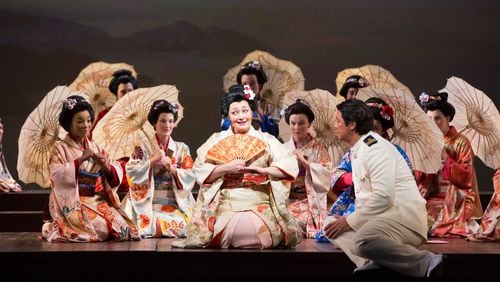CONCERT REVIEW
“Madama Butterfly”
7:30 p.m. Nov. 11; 8 p.m. Nov. 14; and 3 p.m. Nov. 16. $46-$135. Cobb Energy Performing Arts Centre, 2800 Cobb Galleria Parkway, Atlanta. 404-881-8885, www.atlantaopera.org/.
There are few operas more appealing and moving than Giacomo Puccini’s “Madama Butterfly,” and the Atlanta Opera opens its 2014-15 season at the Cobb Energy Centre with a powerful and attractive new production defined by moments of shimmery, cinematic fantasy mixed with genuine pathos that are pure Puccini all the way through.
The most prominent innovation of the production is the use of projections, both on an upstage scrim that is occasionally lowered in front of the action at the opening or closing of a scene and on a downstage screen to show scenes of Nagasaki Bay or cherry trees in bloom when the enormous shoji screens of Butterfly’s house are slid open.
Designer Erhard Rom’s projections can create theatrical magic: In the famous final scene of Act 2 as Butterfly (Dina Kuznetsova) gazes out to the harbor, projections of the sea on the upstage scrim become more and more visible as Butterfly slowly fades away and the Atlanta Opera chorus sings the lovely Humming Chorus.
The screen proves especially serviceable during Puccini’s long orchestral interlude between Acts 2 and 3, though the images — a ship crossing the harbor, a fluttering American flag — are among the show’s most underwhelming. Projections of crashing waves during the final love duet of Act 1 serve up an unpalatable combination of screen saver blandness and schmaltz, a quality that unfortunately can emerge in other scenes, as well.
Use of the screen can be a mixed bag, but one of its strengths is ultimately that it manages to add to the show without ever really dominating: Though the projections can be enormous, surprisingly they never truly overwhelm the dramatic action of the live performers on stage.
The role of Butterfly is strongly associated with its most famous aria, Act 2’s “Un bel dì,” and Kuznetsova does an especially fine job limning the song’s surprisingly varied dramatic shades. The lovely pageantry of her Act 1 entrance backed by the Atlanta Opera chorus is a minor miracle, but it’s actually in Act 3, when the character’s passive waiting finally transforms into frighteningly iron-willed, determined action that Kuznetsova truly shines with an intense dramatic presence that brings the final tragedy to life.
Tenor Adam Diegel was in very fine voice on opening night, which made the character of Pinkerton pop into three dimensions: The seemingly flat, unsympathetic character became, if not exactly likable, at least dashingly jaunty and carefree in Act 1 and filled with a recognizable, awful sense of remorse and self-loathing at the end.
The old adage “there’s no such thing as a small role” usually has the ring of a consoling lie, but Nina Yoshida Nelsen’s performance as Butterfly’s faithful servant Suzuki proves there’s truth in it yet. Vocally and dramatically, she manages to bring a great deal of flair and facility to the role: Nelsen evokes the character’s admirable devotion mixed with deep uncertainty about what’s best for Butterfly. Nelsen also participates in what is certainly one of the production’s highlights, the heart-rending Act 3 trio between Suzuki, Pinkerton and Sharpless (Corey McKern), as the three characters grapple with how to break the news to Butterfly that Pinkerton is not returning.
“Madama Butterfly” is beloved by opera fans, but it’s also a great “no-fear” first opera for viewers unfamiliar with the art form: It’s well-paced and relatively short (well, by opera standards), and it features an accessible and genuinely moving mix of pathos, engrossing story and beautiful melodies. In the hands of the fine cast and under the direction of the company’s new General and Artistic Director Tomer Zvulun, this is opera that’s easy to love.






